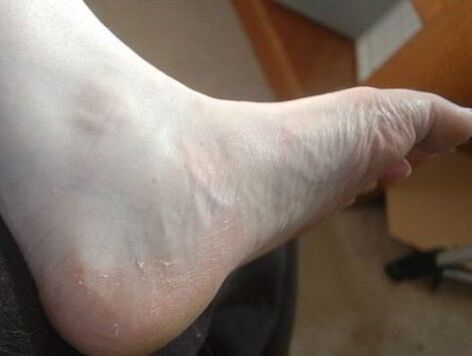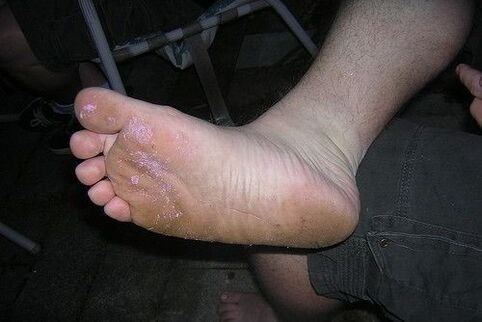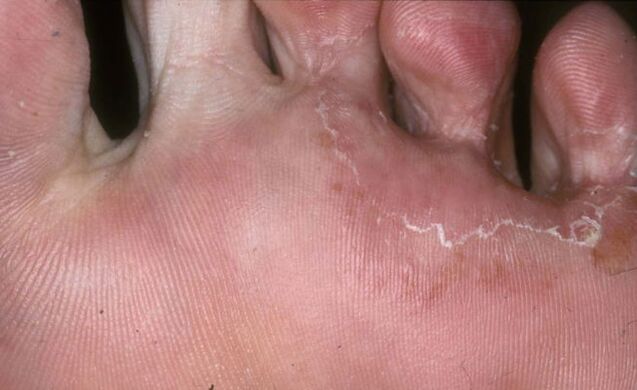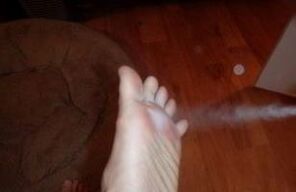Different types of fungi on the human foot are called mycoses. When the skin is affected, the disease belongs to the group of dermatomycoses (epidermophytosis, trichophytosis), because the dermis is translated from the Greek as skin. If the nail is affected, the disease is diagnosed as onychomycosis.

Causes of the disease
Foot fungus is a common disease found all over the world. It is more common in cities than in rural areas. The risk group for foot fungus infection includes athletes, shower workers and hot shop workers. Children have thinner skin that is not protected from external factors, so they are susceptible to mycoses. Another reason is increased sweating of the feet as a result of diseases in the body or a congenital feature. Dermatologists believe that the risk of foot fungus infection increases with age. Factors causing the disease:
- wear indoor uncomfortable leather shoes;
- high-humidity hot environment, which is typical when wearing shoes;
- disruption of blood supply to the extremities;
- frequent visits to crowded places;
- a weak or dysfunctional immune system;
- wear alien shoes.
Rapid infection
Dermatomycosis of the feet is easily transmitted from a sick person to a healthy person in public places. Infection occurs from contact surfaces: floors, household items, personal hygiene items, someone else's shoes. The fungus is transmitted by direct contact, multiplies very rapidly, so it is very easy to infect. During pedicures, as well as in hairdressing salons on towels, cases of fungal infections are not excluded. The disease affects the skin of the feet. It is especially common in men, because they spend most of their time in closed shoes. You don't have to visit gyms, baths, military service often, you always have to wear your own shoe size - all this creates favorable conditions for the growth of pathogenic bacteria. The unventilated area of the room is beneficial for fungi that cause disease to reproduce. The spread of pathogenic flora is very fast. The predominant area of the fungus is the toes and the spaces between the figures. Saunas and baths are characterized by high humidity and high temperature, which are ideal for the growth of pathogenic microflora.
Fungal infections can be direct or indirect. You can be infected by direct contact with a sick person. Indirect contamination involves the use of items used by a sick person.
Manifestations of mycoses
The first sign of the disease is the appearance of scales on the skin in the foot area. Infection occurs through these elements. Increased sweating is a favorable factor for the growth of microbes, because the modified composition of sweat is a nutrient for the growth of pathogenic flora.

Dirt and yarn residue from the sock also collect between the toes. When a fungal infection is added to these factors, redness develops. The affected area begins to itch unbearably and causes discomfort. The skin begins to peel, causing painful cracks. During the walk, there are unpleasant painful sensations due to the presence of sores on the skin of the foot. The skin begins to thicken and the infection can spread to the nails. If left untreated, mycosis spreads and affects the nails, destroying them. The nail plate first changes color to white. Later, it can be torn. Gaps form between the nail plate and the nail bed. An unpleasant odor with a fungus on the feet. When wearing indoor shoes in winter, the foot is not ventilated, and the intensity of damage to the feet increases. For the treatment of this pathology, it is necessary to make an accurate diagnosis, because there are many types of fungal pathogens.
The main types of the disease
- Membrane type (intertriginous form) is the most common. A fungal infection is observed between the fifth and fourth fingers. Gradually the skin acquires a scaly structure with cracked elements. Sometimes a fungal infection is added to the fungus, which causes more damage to the skin of the feet.
- Moccasin type. It manifests itself with pain in the legs. Then the skin thickens, thickens and cracks. Severe fungal lesions occupy the nails, which may begin to disintegrate over time.
- Vesicular type (dyshidrotic form). It manifests itself with the appearance of bubbles under the skin filled with fluid. Often accompanied by a bacterial infection.
Photo with the names of mushroom species on the legs

There are different types of fungi, suitable for different diseases. There are four most common types of fungus that damage the feet.
- Trichophyton rubrum (Trichophytonrubrum) is full of rubrophytosis.
- Trichophyton interdigitale (Trichophytoninterdigitale) affects the skin between the toes, infecting the entire foot. Causes epidermophytosis.
- Trichophyton mentagrophytes cause complete epidermophytosis.
- Candida albicans is a female fungus. It causes candidiasis of the feet, but this is rare.

Epidermophytosis and trichophytosis (rubromycosis) are skin diseases caused by parasitic fungi of the genus Dermatophyte, called mycosis of the feet.
Classification
Dermatophyte fungi:
- microspores;
- epidermophyton;
- t.
Molds that cause fungal diseases:
- hendersonula;
- altemia;
- s.
Yeast pathogenic fungi:
- pityrosporum;
- candidacy;
- cryptococcus;
- malassezia;
- coccidoids;
- histoplasm;
- w.
Preventive measures

Since mushrooms love a warm, humid environment, it shows that they need to break down to get rid of these conditions. For this reason, feet should be clean and dry to prevent fungus. It is important to change your socks and dry your shoes on time. There are special antiperspirants on the market that will prevent the growth of pathogenic microflora. It is better to choose leather shoes to maintain normal metabolic processes between the feet and the environment. The feet will sweat less and there will be no conditions for fungi to reproduce. It is advisable to wear socks that you take off and wash at home, and germs and dirt will accumulate in your shoes.
You only need to use your own things, because you do not know that someone else has a disease. Your immune system is not able to cope with pathogens and become infected. You need to ventilate your shoes more often. It is also advisable to take personal hygiene products when walking in public places. Never walk barefoot in swimming pools and showers. The use of prophylactic antifungal creams and ointments also helps. After all, swimming pools, dressing rooms, saunas and other rooms with high humidity are grounds for reproduction of the fungus. In the bathroom at home, it is better to give up porous carpets.
Risk group
There are people who are more susceptible to this disease than others. This may be due to problems in the body:
- excess weight;
- circulatory disorders in the legs;
- deformities of straight legs and feet;
- immunity system;
- stressed people;
- after antibiotic treatment.
Diagnosis of fungal diseases of the feet
The doctor conducts a detailed examination of the foot, asks questions. Skin samples are taken from the patient for fungal examination. A piece of leather, small, specially made, is obtained by scratching the foot. For analysis, the nail fungus is cut from the infected area. The presence of mycosis is determined by special tests. Cultivated to determine the type of mushroom, ie grown. In rare cases, a biopsy may be ordered in a patient with an advanced stage of the disease. In this case, the prepared material is examined under a microscope.
Treatment methods
To get the result of treatment, it is necessary to determine the type of fungus and, if any, the presence of infection. The degree of damage is also taken into account.
The basis of membrane-type treatment seems to be the application of antifungal drugs to the affected area. It is convenient to do it at home. These drugs stop the growth of bacteria or slow the spread of the disease. Most of these drugs are sold without a prescription. The effect of the substance occurs locally, where it is applied to the affected skin. It is important to monitor the dynamics of treatment, if there is no improvement, the drug does not help you.

If there is no effect of the agent used, it is necessary to consult a dermatologist again to prescribe another treatment. You may need to prescribe a stronger medication. Tablets are prescribed especially in severe cases of the disease. Many medications have side effects, so it is important to monitor your blood count during treatment with pills. It is very difficult to completely cure the fungus because it can recur. Treatment should not be stopped, otherwise the fungi may become resistant to the components of the drug that affect them. The cleanliness and dryness of the foot should be monitored during treatment. With a moccasin-like form of infection, onychomycosis, or damage to the nails, often occurs. This disease is more difficult to treat because the skin on the legs thickens and it is more difficult for drugs to penetrate. In this case, standard drugs "do not work" and additional therapy in the form of pills is prescribed. Onychomycosis - damage to the toenails by a fungus of the genus Dermatophyte. Yeast and molds can also cause the disease. There are several types of onychomycosis:
- Distal subungual. Depending on the area of damage to the nail plate, there are three degrees of damage. If the nail is presented in one part and conventionally divided into three parts (depth), then the lesion will correspond to two-thirds of its volume to the first two stages of the disease. And when more than 2/3 of the nail is affected by the fungus, it is already the third degree. In this condition, the root of the nail (matrix) is involved in the disease process, and sometimes the skin wrinkles, called periungual ridges on the sides of the nail;
- proximal subungual. Defeat of the back of the nail plate where the hole is;
- surface white. This type of onychomycosis is common in the feet;
- general dystrophic. Final completion stage.
In the vesicular type, the doctor may prescribe the removal of the upper part of the blisters. Then all the liquid flowing from them is eliminated. The area is dried, an antifungal cream or a special compress is applied. If a bacterial infection is detected, a course of antibiotics is prescribed. Sometimes the disease is accompanied by a fever. Acute infections respond better to treatment than chronic fungal and slow processes. In severe cases, hormonal drugs are prescribed. Antifungal medications are taken until complete recovery. When all the fungi do not die and the medication is discontinued, the disease reappears.
If the patient is not treated, the disease will become chronic and a severe bacterial infection will develop. In addition to the foot, the skin of the toes can also be affected.
Traditional medicine offers compresses and lotions for the treatment of nail fungus using tea tree oil, which has an anti-inflammatory effect next to garlic. Regular washing with detergents does not always destroy pathogenic bacteria. To remove the fungus from the clothes, the linen should be washed in warm water or boiled if possible. We recommend using bleach and a hot iron.
























